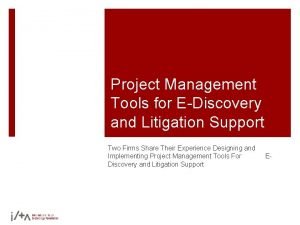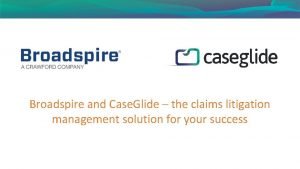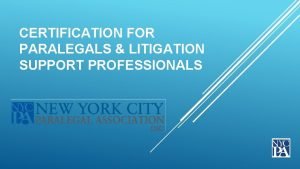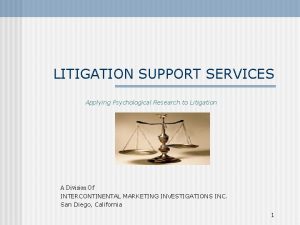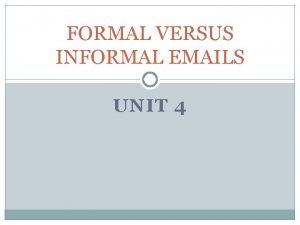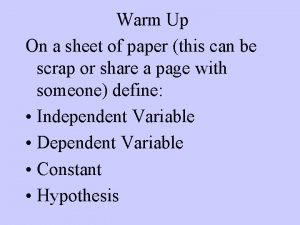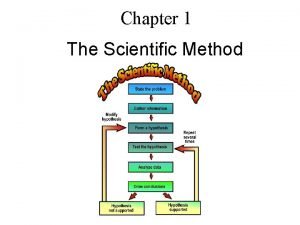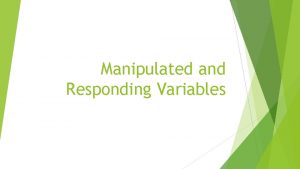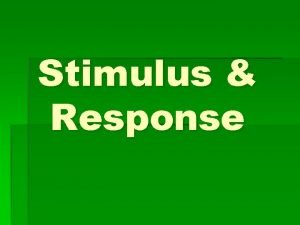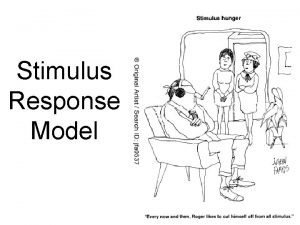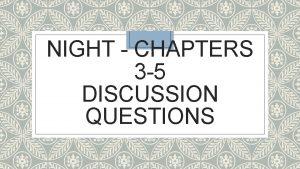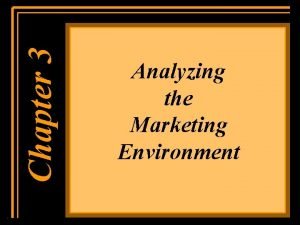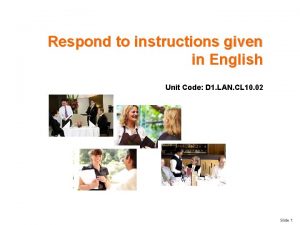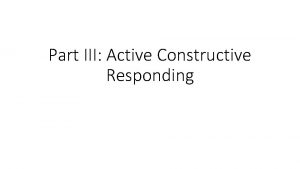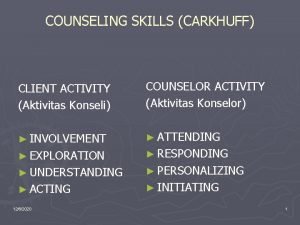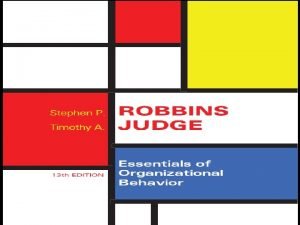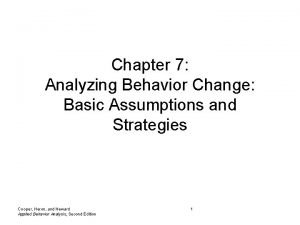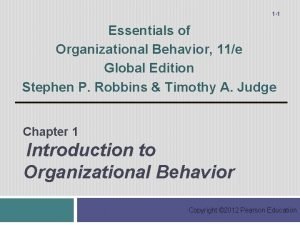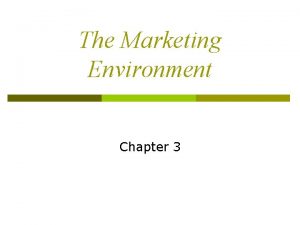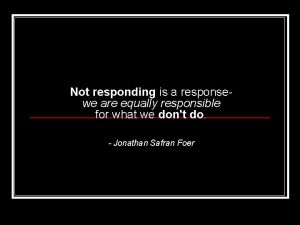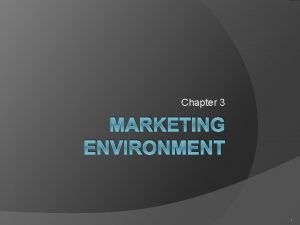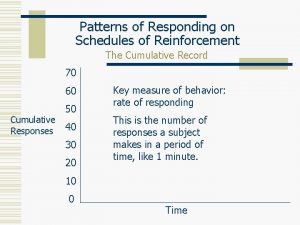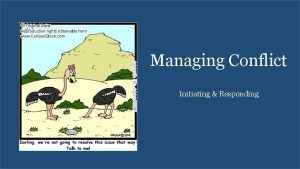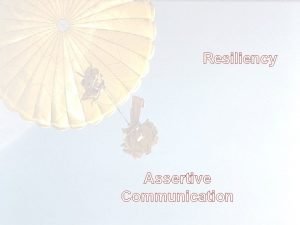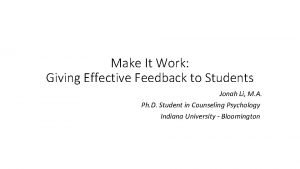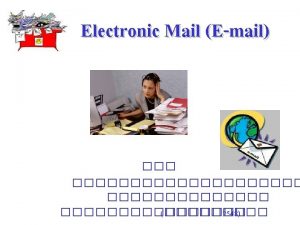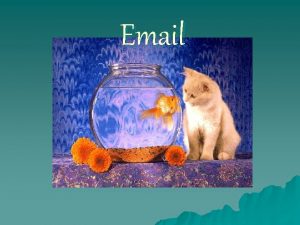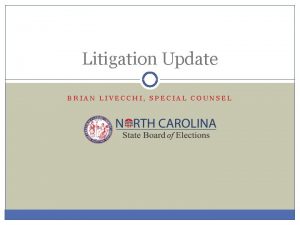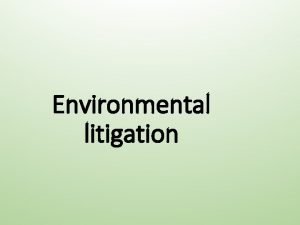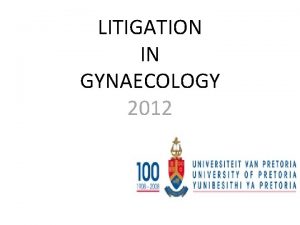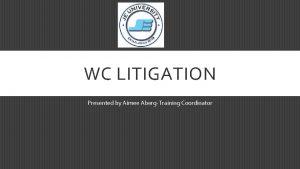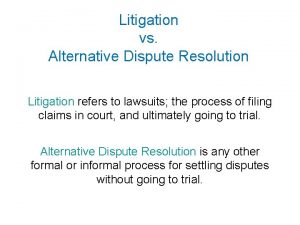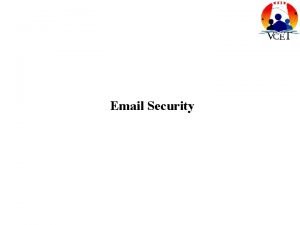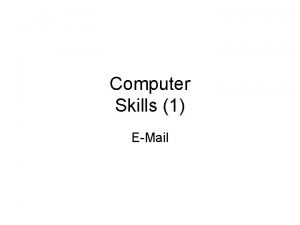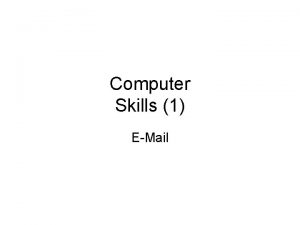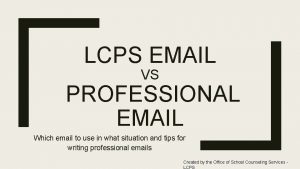Solutions for EMail Management and Responding to Litigation




































































- Slides: 68

Solutions for E-Mail Management and Responding to Litigation Holds: A Case Study Laura A. Dunek Associate System Legal Counsel Regent Records Policy Advisor Office of General Counsel University of Wisconsin System (608) 262 -0747 ldunek@uwsa. edu

Overview of Session Litigation: Properly identify, hold, and manage electronically-stored information. Records Management: Successfully manage email and other forms of business communication.

Federal Rules of Civil Procedure (FRCP): “Discovery” FRCP governs what information you need to produce when you are involved in litigation. “Discovery” in litigation refers to disclosure of documents and other information relevant to a legal claim. “Discoverable” information is anything that would reasonably lead to admissible evidence at trial.

Amendments to the Federal Rules of Civil Procedure RULES, COMMITTEE NOTES, AND COMMENTARY AT: www. uscourts. gov

Discovery: New Form of Evidence How would you define the mighty phrase? “Electronically-stored Information”

“electronically stored information” Rule 34(a) Comment: As originally adopted, Rule 34 focused on discovery of “documents” and “things. ” But it has become increasingly difficult to say that all forms of electronically stored information, many dynamic in nature fit within the traditional concept of a “document. ”

ESI: “electronically stored information” Rule 34(a) is amended to confirm that discovery of electronically stored information stands on equal footing with discovery of paper documents. Rule 34(a) is expansive and includes any type of information that is stored electronically.

ESI: “electronically stored information” Rule 34(a) Comment: The rule covers—either as documents or as electronically stored information—information stored in any medium, to encompass future developments in computer technology. Rule 34(a) is intended to be broad enough to cover all current types of computer-based information, and flexible enough to encompass future changes and developments.

FRCP 34: Production of Documents in Litigation Rule 34 encompasses everything: › › › › Email and text messages Voicemail Backup tapes Metadata Logs Fragments of deleted documents Multiple copies of the same document/email Home computers and personal tools of technology, such as cell phones and Blackberrys

Additional Amendments to the Federal Rules of Civil Procedure Rule 16: Pre-trial procedure and case management Rule 26: General duty of disclosure Rule 33: Questions to parties Rule 45: Subpoenas

Amendments to the Federal Rules of Civil Procedure EARLY ATTENTION TO ELECTRONIC DISCOVERY: RULES 16 AND 26(f), FORM 35 Rule 16(b)(5): The scheduling order shall issue within 90 days after the appearance of a defendant or within 120 days after the complaint has been served on a defendant. The scheduling order may include “provisions for disclosure or discovery of electronically stored information. ”

Amendments to the Federal Rules of Civil Procedure Rule 26: Inventory of Electronic Records is the First Step in the Litigation Process: Unless otherwise exempted, a party must provide to other parties a copy of, or a description by category and location of, all documents, electronically stored information, and tangible things that are in the possession, custody, or control of the party and that the disclosing party may use to support its claims or defenses, unless solely for impeachment.

Discovery Plan Rule 26: General Provisions Governing Discovery. Parties are required to develop a discovery plan concerning any issues relating to the disclosure or discovery of electronically stored information, including the form or forms in which it should be produced.

FRCP 34: Production of Documents Rule 34: The responding party must identify, by category or type, the sources containing potentially responsive information that it is either searching nor producing. The identification should provide enough detail to enable the requesting party to evaluate the burdens and costs of providing the discovery and the likelihood of finding responsive information on the identified sources.

Amendments to the Federal Rules of Civil Procedure Rule 34: A party’s identification of sources of electronically stored information as not reasonably accessible does not relieve the party of its common-law or statutory duties to preserve evidence. A party my be required to preserve unsearched sources of information in some cases.

Amendments to the Federal Rules of Civil Procedure RULE 26(b)(2): REASONABLY ACCESSIBLE INFORMATION; BETTER MANAGEMENT OF ELECTRONIC DISCOVERY This rule places limitations on discovery of electronically stored information that the party identifies as not reasonably accessible because of undue burden or cost. Even if the party makes a showing of undue burden or cost, the court may order discovery if the requesting party shows good cause—a balancing of costs and benefits. Committee Note sets forth a seven prong balancing test, and suggests that sampling may be helpful in some cases.

Approach to Discovery Early and ongoing involvement of information technology professionals is essential for success. Format is of paramount concern. Duplicative records and storage costs are of paramount concern.

When Do Discovery Obligations Start? When party “reasonably anticipates litigation, ” it must suspend its routine document retention/destruction practices and implement “litigation hold. ”

When Do We “Reasonably Anticipate Litigation”? When a complaint or court order is served When litigation is “reasonably foreseeable”? Factors: › › › Major accident or injury occurs Police report filed Claim is filed with administrative agency Employee is fired Claimant threatens litigation

Effective Litigation Hold Process 1. Issue a litigation hold. 2. Identify Affected Employees and Develop Action Plan. 3. Monitor the Process and Seek Release of Duplicative Evidence. 4. Create Separate Drive for Evidence. 5. Terminate Litigation Hold.

Case Study: UW System Process Review Five Step Process Developed for UW System.

Issue a Litigation Hold Sample Letter

A Litigation Hold Letter Should … Identify claimant and nature of claim. Remind employees of their legal duty to preserve relevant ESI. Identify the team that is managing the situation. Direct employees to suspend deletion, overwriting and destruction of relevant ESI. Direct employees to preserve new relevant ESI. Preserve all hard copies.

Release of Duplicative Evidence Sample Request Letter Supporting Inventory

The Antecedent Question Before litigation occurs, how do we manage it all?

The Difficulty of Managing “electronically stored information” Lack of Guidance Results in: › Misuse of Business Tools › Needless Retention of electronically stored information Employees Engage in Inappropriate Communication

Bush Aides' Misuse of E-Mail Detailed by House Committee Washington Post, June 19, 2007 White House aides made extensive use of political e-mail accounts for official government business, despite rules requiring that they conduct such business through official communications channels, according to new evidence disclosed yesterday by congressional investigators.

Racy texts contradict testimony from Detroit mayor, aide (CNN) -- Detroit Mayor Kwame Kilpatrick exchanged nearly 14, 000 text messages regarding his extramariatl affair with his Chief of Staff, Christine Beatty, on her city-issued pager. "I'm madly in love with you, " the married Kilpatrick wrote on October 3, 2002. Beatty replied, "I hope you feel that way for a long time. "

Develop a Legally Compliant Records Management Program Records Management Policy. Employee Training. Must not only inform but also provide tools, so employees can successfully comply with the policy. Compliance Review. Supervisory review, compliance audits, and/or automatically log employee activities.

Policy Development: Effective Electronic Records Management

Who Should Be Involved? Key Leaders within the Organization IT Personnel Records Officers Lawyers Auditors Finance Officers Human Resources

Public Sector: Most Complex Arena for Managing Email Public institutions have legal requirements, which are not applicable in the public sector. Hence, a records management policy must comply with myriad legal requirements.

Case Study: The University of Wisconsin System

University of Wisconsin: Statutory Requirements State of Wisconsin Statutes set forth legal requirements for management and public release of public records.

Wisconsin’s Records Statutes Wis. Stats. §§ 16. 61 and 19. 32 What is a “public record”?

Wisconsin’s Records Management Statute Wis. Stats. § 16. 61 Public records include all materials, regardless of physical form or characteristics, made or received by any state agency in connection with the transaction of public business.

Wisconsin’s Public Records Statute Wis. Stats. § 19. 32 “Record” means any material regardless of physical form or characteristics, which has been created or is being kept by an authority and upon which written, drawn, printed, spoken, visual or electromagnetic information is recorded or preserved.

University of Wisconsin: Regulatory Requirements State of Wisconsin Regulations set forth legal requirements for electronic records.

Administrative Rule 12: Electronic Records Adm 12. 02 Purpose. The purpose of this chapter is to ensure that public records in electronic format are preserved and maintained and remain accessible for their designated retention period.

Administrative Rule 12: Electronic Records Adm 12. 05 Provisions. State and local agencies shall comply with all statutes and rules relating to public records. With regard to public records stored exclusively in electronic format, state and local agencies shall do all of the following: (1) Maintain electronic public records that are accessible, accurate, authentic, reliable, legible, and readable throughout the record life cycle.

PUBLIC RECORDS BOARD: Powers and Duties All public records made or received by or in the custody of a state agency shall be and remain the property of the state. Those public records may not be disposed of without the written approval of the board. Wis. Stats. § 16. 61(4)(a)

Oversight and Enforcement: Public Records Management The State of Wisconsin Public Records Board shall safeguard the legal, financial, and historical interests of the state in public records. Wis. Stats. § 16. 61(3)(a)

Board of Regents Policy University of Wisconsin System Public Records Management

University of Wisconsin Business Communication Records Schedules University of Wisconsin employees now have the legal authority to classify, manage, and destroy public records.

Business Communication: Questions How would you define the term: Business Communication?

Business Communication: Records Categories Communication that is memorialized in any format and related to the transaction of public business. Two Categories: 1. Business Communication: Transitory 2. Business Communication: Routine

Business Communication: Transitory Directly connected to the transaction of public business, but of minimal, short-term business value. Replaces in-person conversation. Can be memorialized using many different types of business tools, including email, voicemail, and text messages.

Examples: Transitory Business Communication (1) Communication that is not the basis for official action, such as holiday notices, charity and welfare appeals, or information about workplace events. (2) Scheduling information pertaining to an event that has already occurred.

Examples: Transitory Business Communication (3) Courtesy copies that do not require responsive action by the employee who receives the communication. (4) Reference materials that are created or received from a distribution list, listserv, or other resource provider. (5) A draft version of a document that has been shared for review among colleagues, after the draft has been superseded by a successive version of the document

Examples: Transitory Business Communication (6) Scheduling information pertaining to an event that has already occurred. (7) Requests for information or materials to which a university employee can easily reply, without performing special research, engaging administrative processes, or seeking supervisory review.

Business Communication: Transitory Analyze the Following Examples: How does each example fit within the definition of transitory communication?




Retention Time Period: Transitory Communication Retain for seven days after the transitory communication is created or received. Or delete the transitory communication when obsolete because it has been superseded or the related event has transpired.

Retention Time Period If a communication has ongoing value, then retain it for as long as you need it as a business resource. Retain transitory communications until you can accurately classify them.

Business Communication: Routine Directly connected to the transaction of business performed by employees. Comprises the normal communication that occurs between team members working to complete projects. Includes attachments to the communication. Can be memorialized using many different types of business tools.

Routine Communication: Examples (1) Employees in different physical locations discuss and perform routine aspects of business activities; (2) Employees administer routine facets of a university activity or business project; or (3) Employees disseminate to their colleagues routine materials related to a business project.

Business Communication: Routine Analyze the Following Examples: How does each example fit within the definition of routine communication?

Business Communication: Routine


Retention Time Period Retain for six months after a business project is completed. If a communication has ongoing value, then retain it until you no longer need it as a business resource. Retain business communications until you can accurately classify them as either routine or transitory.

TRAINING: UW System Employees Desktop Webcasts: › http: //www. uwex. edu/ics/webcast/ Employee Training at UW Campuses: Developed and led by Records Officers at each campus.

TRAINING: UW System Employees Records Management Resources for all UW employees: Online and sponsored by UW System. › http: //www. uwsa. edu/gc-off/records/

COMPLIANCE REQUIREMENTS ۩ Internal Audits of employee email accounts performed by Information Services on a quarterly basis. ۩ Management team reviews audit results and oversees employee compliance.

Practical Guidance: Managing an Email Account Folders Sub-folders Retention Policy Store off-line

File Management for Business Communication Entire content of the message, including entire chain of communication from previous authors. Include all Attachments Complete Metadata: Date: To: From: Subject:

Appropriate Content for Business Communication Professional tone Related to the business of the University Before pressing the “send” button, scrutinize the content of your email messages. Any business communication could be printed in a news story, read on air by a reporter, or posted on the web.
 Litigation project management
Litigation project management Case glide
Case glide Litigation support professionals
Litigation support professionals Research & litigation support
Research & litigation support Formal and informal emails
Formal and informal emails Manipulated variable and responding variable graph
Manipulated variable and responding variable graph Why are line graphs powerful tools in science?
Why are line graphs powerful tools in science? Congratulating and responding
Congratulating and responding What is the fourth step of the scientific method
What is the fourth step of the scientific method Manipulated variable
Manipulated variable Making and responding to requests 2 bac
Making and responding to requests 2 bac Ubrs training
Ubrs training Responding to internal stimuli
Responding to internal stimuli Stimulus response chart
Stimulus response chart Night discussion questions by chapter
Night discussion questions by chapter Domains of learning
Domains of learning Responding to peer pressure by shouting insults is
Responding to peer pressure by shouting insults is Evidence crime scene
Evidence crime scene Responding to the marketing environment
Responding to the marketing environment Responding to internal stimuli
Responding to internal stimuli Responding to the environment
Responding to the environment Responding to instructions examples
Responding to instructions examples Joy multiplier
Joy multiplier Eft cycle
Eft cycle Cpi crisis development model
Cpi crisis development model Attending responding personalizing initiating
Attending responding personalizing initiating Responding to economic pressures
Responding to economic pressures Prediction verification replication aba
Prediction verification replication aba Responding to economic pressures in ob
Responding to economic pressures in ob Natural environment marketing
Natural environment marketing Not responding is a response
Not responding is a response Responding to globalization in ob
Responding to globalization in ob Macro environment in marketing
Macro environment in marketing Scalloped pattern of responding
Scalloped pattern of responding What is parallel lines
What is parallel lines Responding sides
Responding sides Score pulmonar pediatrica
Score pulmonar pediatrica Affective learning outcomes
Affective learning outcomes Active constructive responding
Active constructive responding Active constructive responding
Active constructive responding Fspos vägledning för kontinuitetshantering
Fspos vägledning för kontinuitetshantering Typiska drag för en novell
Typiska drag för en novell Tack för att ni lyssnade bild
Tack för att ni lyssnade bild Ekologiskt fotavtryck
Ekologiskt fotavtryck Shingelfrisyren
Shingelfrisyren En lathund för arbete med kontinuitetshantering
En lathund för arbete med kontinuitetshantering Adressändring ideell förening
Adressändring ideell förening Personlig tidbok fylla i
Personlig tidbok fylla i Sura för anatom
Sura för anatom Förklara densitet för barn
Förklara densitet för barn Datorkunskap för nybörjare
Datorkunskap för nybörjare Tack för att ni lyssnade bild
Tack för att ni lyssnade bild Debattartikel struktur
Debattartikel struktur Delegerande ledarstil
Delegerande ledarstil Nyckelkompetenser för livslångt lärande
Nyckelkompetenser för livslångt lärande Påbyggnader för flakfordon
Påbyggnader för flakfordon Lufttryck formel
Lufttryck formel Publik sektor
Publik sektor Lyckans minut erik lindorm analys
Lyckans minut erik lindorm analys Presentera för publik crossboss
Presentera för publik crossboss Jiddisch
Jiddisch Bat mitza
Bat mitza Treserva lathund
Treserva lathund Luftstrupen för medicinare
Luftstrupen för medicinare Bästa kameran för astrofoto
Bästa kameran för astrofoto Cks
Cks Verifikationsplan
Verifikationsplan Mat för unga idrottare
Mat för unga idrottare Verktyg för automatisering av utbetalningar
Verktyg för automatisering av utbetalningar
